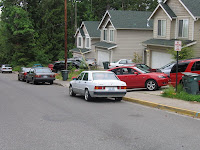HEALTH AND SAFETY; More than 50% of Bellingham's housing stock are rentals, yet no program exists to ensure the health and safety of renters. Bellingham should have an ordinance that will protect renters. ZONING ENFORCEMENT: Additionally, by ignoring its own zoning codes, the Bellingham city government has turned neighborhoods into rooming house districts. You can demand the enforcement of zoning codes, too.
Friday, June 27, 2008
A Whole Lot of Noodle Pushing Goin' On!
I am happy to hear from Chief Ramsay that the number of letters sent to landlords this year has dropped, however, that is not a measure of an amelioration of a zoning/density problem. Until the council acts on demanding enforcement, I would not believe anything they or Mr Stewart promise about infill (e.g. the neighborhoods decide "the where") since both (including former Directors of Planning) have allowed illegal infill to take place for the last several decades. The truth is that "the where" is controlled by landlords. Keep that in mind.
Wednesday, June 4, 2008
We Do Not Know. But Do We Want To Know?
So my friend writes: “All over town. Another wrinkle. A neighbor (retired fire dept) called the inspection wing of the BFD [Bellingham Fire Department], requesting a inspection of one of the rooming houses in our neighborhood, as he felt it was a very unsafe house for those living there as some of the "added" bedrooms have no proper exits in the event of fire. Fire dept informed him it’s a Permit dept problem, Permit dept states it a law enforcement problem, law enforcement has been told by the city attorney’s office to "do nothing". Do not motels, hotels, licensed group residences, etc have to be inspected by the BFD for safety? Meeting rooms have a max capacity set by the BFD! Sure do enjoy merry-go-rounds.”


From Firehouse Magazine (July 2005) there is this, "A nationwide campaign is underway to reduce the number of fire deaths at colleges and universities, with special emphasis on off-campus housing, where more than 75% of these fatalities occur." Did you know that? Have you heard of such a campaign in Bellingham? What sort of liability is the City of Bellingham courting by not having a landlord law under which single family rentals can be inspected for safety? Fifty percent of our single family homes are rented but we have no idea regarding the condition of these structures. You can train the renters but if the basic amenities, which provide the house with a secure environment, are missing, all the training will have been for naught. For more on this subject, read an article entitled "After N.C. deaths, fire safety concerns come to light" in the Tufts Daily by clicking here.
A further example: "The fire call came in at 4:50 am … careless smoking on that porch had set that old wooden house ablaze … there was only one way out and it was through the porch. There were no sprinklers and reportedly not all of the smoke detectors were working. Liz and two of her roommates died of smoke inhalation that day." More information on this incident and on off-campus fires can be found at Campus Firewatch by clicking here.
Here are some nationwide statistics from Campus Firewatch.
| Campus-related fire fatalities from January 2000 to March 16, 2007 | ||
|---|---|---|
| Off-campus | 87 | 80% |
Residence Hall | 10 | 9% |
| Greek housing | 10 | 9% |
| Other | 1 | 1% |
| Total | 108 | |
Well, what is known about rentals of single family homes here in
Have landlords added or modified bedrooms? We do not know.
Do all bedrooms have fire exits? We do not know.
Do these rentals have smoke detectors? We do not know.
Do these rentals have carbon monoxide detectors? We do not know.
Do these rentals have adequate wiring? We do not know.
Do these rentals have adequate plumbing? We do not know.
Do these rentals have adequate heating? We do not know.
Do these rentals have mold or mildew problems? We do not know.
Do these rentals have insect infestations? We do not know.
Do these rentals have gas leaks? We do not know.
Do these rentals have structural problems? We do not know.
Do these rentals have other safety or health issues? We do not know.
Is there overcrowding in these rentals? We do not know.
Are necessary repairs made by landlords? We do not know.
Is there price gouging by landlords? We do not know.
Is there a system of inspections of rental homes in
Are landlords of rental homes licensed by the city? We do know. None.
Will it take a death or serious injury to spur the city to action?
Do we want to know?
Tuesday, June 3, 2008
Zonemaven Academy II
It may be instructive then to look at the presentation made during the
These are “snout houses” (with protruding garages in front) on small lots along
Here are some small lots on a cul-de-sac off
This is a morning panorama on a street in the Magnolia Hills subdivision.
As for accessory dwelling units, among which I include carriage houses, the prescription that either the main house or the accessory unit must be occupied is of little comfort for the simple reason that economics will soon drive the homeowner to the accessory unit at which time he or she will rent the “big house” to maximize returns on the rental. At the last Samish Neighborhood annual meeting our Director of Planning mentioned this as being an attractive alternative. Why rent the ADU at $400 per month when renting the house will bring in $1,500 to $2,000 per month? The residency rule may attenuate somewhat any propensity on the part of the renters to engage in un-neighborly behaviors but the amount of infill will be distorted. One rents an ADU to one or two people. The “big house” will attract many more and double or triple the density into what we call an illegal rooming house. And then there are the cars...
So now we arrive at “the how”. Here is how the city tends to enforce housing codes. These examples were found in a matter of hours in widely scattered neighborhoods and are surrounded by modest and well kept homes.
 The question for the citizenry is, “How ('The How') will the City Council and the city government enforce future codes on the housing described above when its efforts to date have allowed for a proliferation of illegal rooming houses, derelict homes, and residences where boats, trailers, cars and various sorts of containers are treated as lawn ornaments?” I know that our new Chief of Police, Todd Ramsay, is working diligently on a method of enforcement but will the political will of the Mayor and the City Council be there at the moment of implementation?
The question for the citizenry is, “How ('The How') will the City Council and the city government enforce future codes on the housing described above when its efforts to date have allowed for a proliferation of illegal rooming houses, derelict homes, and residences where boats, trailers, cars and various sorts of containers are treated as lawn ornaments?” I know that our new Chief of Police, Todd Ramsay, is working diligently on a method of enforcement but will the political will of the Mayor and the City Council be there at the moment of implementation?







